TOC
Open TOC
- C++ 中 struct 与 class 的区别与比较
- Object Based
- Header 中的防卫式声明
- inline 内联函数
- access level 访问级别
- constructor 构造函数
- const member functions 常量成员函数
- 参数传递:pass by value vs. pass by reference (to const)
- 返回值传递:return by value vs. return by reference (to const)
- friend 友元
- operator overloading (成员函数) this
- operator overloading (非成员函数) 无 this
- temp object (临时对象) typename ()
- Big Three
- 生命期
- 探索 new 操作
- 探索 delete 操作
- 探索创建对象的内存分配情况
- 进一步补充:static
- 进一步补充:namespace
- 进一步补充:cout
- Object Oriented
- 转换函数
- pointer-like classes
- function-like classes
- class template 类模板
- function template 函数模板
- member template 成员模板
- specialization 模版特化
- partial specialization 模版偏特化
- template template parameter 模板模板参数
- C++ 标准库速览
- reference
- Object Model 对象模型
- 关于 new 和 delete
- C++ 2.0
C++ 中 struct 与 class 的区别与比较
- struct 默认访问权限是 public 的,而 class 默认为 private 的
- struct 默认继承关系是 public 的,而 class 默认为 private 的
struct A {};
class B : A { // 默认为 private 继承};
struct C : B { // 默认为 public 继承};- class 这个关键字还可用于定义模板参数,就像 typename
在 C 中使用结构体时需要加上 struct,或者对结构体使用 typedef 取别名,而 C++ 可直接使用
Object Based
- Class without pointer member(s)
complex 类
- Class with pointer member(s)
string 类
必须有 copy ctor 和 copy op=
Header 中的防卫式声明
#ifndef __COMPLEX__#define __COMPLEX__
...
#endifinline 内联函数
在类内部定义的成员函数默认为 inline
inline 仅建议编译器内联
access level 访问级别
- public
- private
- protected
- 派生类的成员函数中可以访问基类的保护成员
constructor 构造函数
default argument
可能引发构造函数 overloading 冲突
initialization list
发生在 assignments 之前
设计模式 - Singleton - 构造函数 private
class A {public: static A &getInstance();
A(const A &rhs) = delete;
void setup() {}
private: A() = default;};
A &A::getInstance() { static A a; return a;}
int main() { A::getInstance().setup();}考虑 delete 关键字
此处不将 static A a 放在类声明里面,是考虑到 lazy load
const member functions 常量成员函数
- 常量对象只能调用常量成员函数
- 非常量对象可以调用非常量成员函数,也可以调用常量成员函数
- const 是函数签名的一部分,可以用于重载
- 当成员函数的 const 和 non-const 版本同时存在
- const object 只会调用 const 版本
- non-const object 只会调用 non-const 版本
参数传递:pass by value vs. pass by reference (to const)
Item 41: 对于那些可移动总是被拷贝的形参使用传值方式
因为引用传递参数和值传递参数的用法相同,所以两个函数的函数签名 (signature) 相同,不能同时存在
double imag(const double &im);double imag(const double im);返回值传递:return by value vs. return by reference (to const)
传递者无需知道接收者是以 reference 形式接收
与指针对比
- 若返回值类型为 pointer,则必须返回一个 pointer
- 若返回值类型为 reference,可以返回一个 object,也可以返回一个 reference
friend 友元
相同 class 的各个 objects 互为 friends
class complex {public: explicit complex(double r = 0, double i = 0) : re(r), im(i) {}
double func(const complex ¶m) { return param.re + param.im; }
private: double re, im;};
int main() { complex c1(2, 1); complex c2; c2.func(c1);}operator overloading (成员函数) this
隐式 this
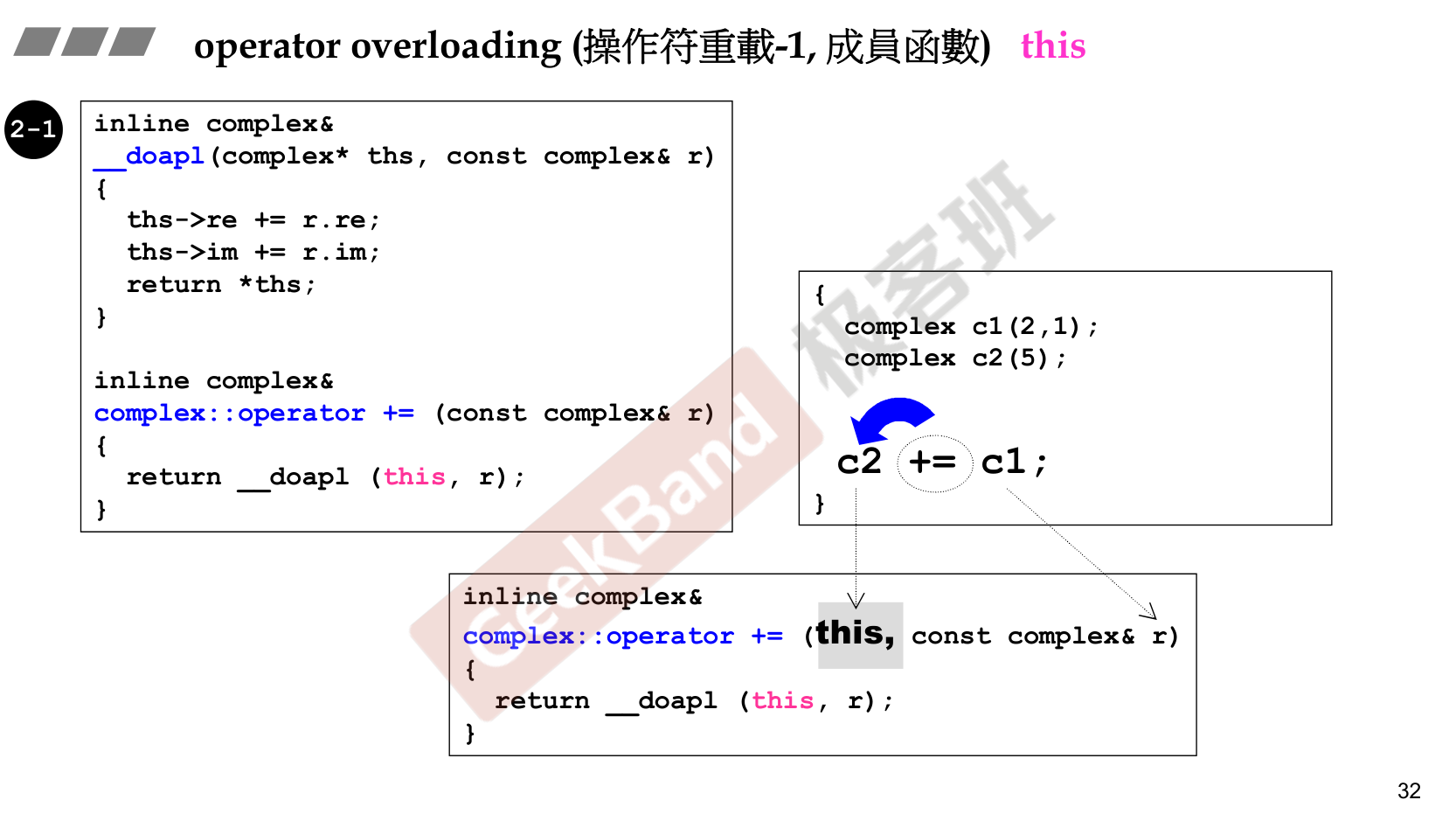
operator overloading (非成员函数) 无 this
重载 cout
ostream &operator<<(ostream &os, const complex &x) { return os << '(' << real(x) << ',' << imag(x) << ')';}- 不可能是成员函数,因为 cout 不认识 complex 类
- friend 可选
- return by reference 必选
temp object (临时对象) typename ()
绝不可 return by reference
因为返回的必定是个 local object
inline complexoperator+(const complex &x, const complex &y) { return complex(real(x) + real(y), imag(x) + imag(y));}
inline complexoperator+(const complex &x, double y) { return complex(real(x) + y, imag(x));}
inline complexoperator+(double x, const complex &y) { return complex(x + real(y), imag(y));}Big Three
class String {public: String(const char *cstr = 0);
String(const String &str);
String &operator=(const String &str);
~String();
char *get_c_str() const { return m_data; }
private: char *m_data;};- 拷贝构造
必须是 pass by reference
如果类 A 的拷⻉构造函数的参数不是引⽤传递,⽽是采⽤值传递,那么就⼜需要为了创建传递给拷⻉构造函数的参数的临时对象,⽽⼜⼀次调⽤类 A 的拷⻉构造函数,这就是⼀个⽆限递归
- 拷贝赋值
检测 self assignment
inline String &String::operator=(const String &str) { if (this == &str) // or (*this == str) return *this; delete[] m_data; m_data = new char[strlen(str.m_data) + 1]; strcpy(m_data, str.m_data); return *this;}- 析构
生命期
- stack objects
- 其生命在作用域 (scope) 結束之際結束
- static local objects
- 其生命在作用域 (scope) 結束之後仍然存在,直到整個程序結束
- global objects
- 其生命在整個程序結束之後才結束
- 你也可以把它視為一種 static object,其作用域是「整個程序」
- heap objects
- 其生命在它被 deleted 之際結束
探索 new 操作
- 先分配 memory
- 再调用 ctor
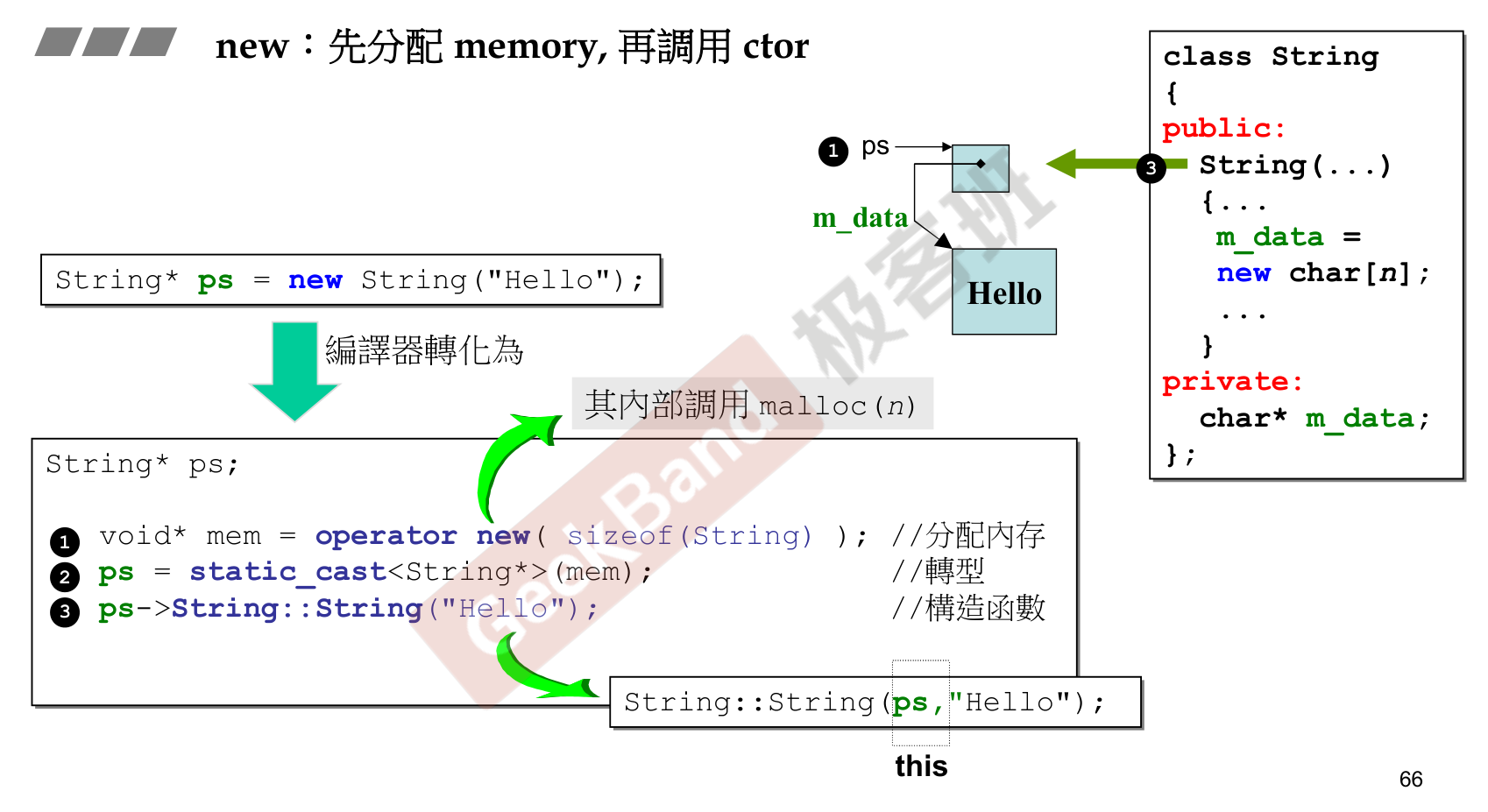
探索 delete 操作
- 先调用 dtor
- 再释放 memory
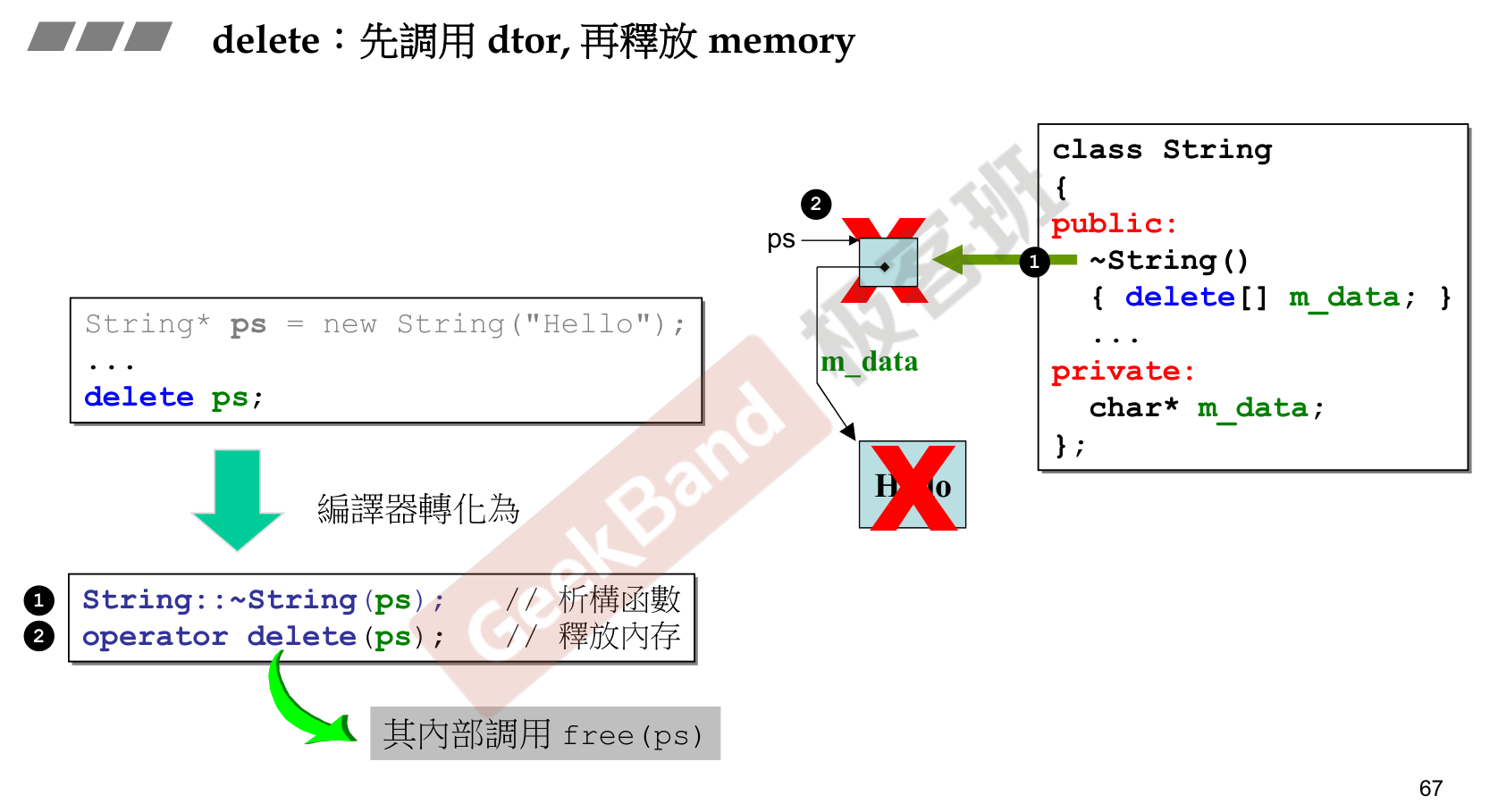
探索创建对象的内存分配情况
array new 一定要搭配 array delete

32 位环境下
注意内存分配的 header 和 footer 为 21h,代表大小为 32 且已分配
如果不使用 array delete,实际上分配给类本身内存可以被完整回收,但是构造函数中分配给 data 的内存会泄露
如果换成 complex 类,也许就不会发生内存泄漏
进一步补充:static
static 成员变量,类的里面是声明,类的外面才是定义 / 分配内存
调用 static 成员函数的方式有二
- 通过 object 调用
- 通过 class name 调用
进一步补充:namespace
- using directive
using namespace std;- using declaration
using std::cout;进一步补充:cout
虚继承
Object Oriented
Composition
构造与析构顺序
默认调用 default 构造函数
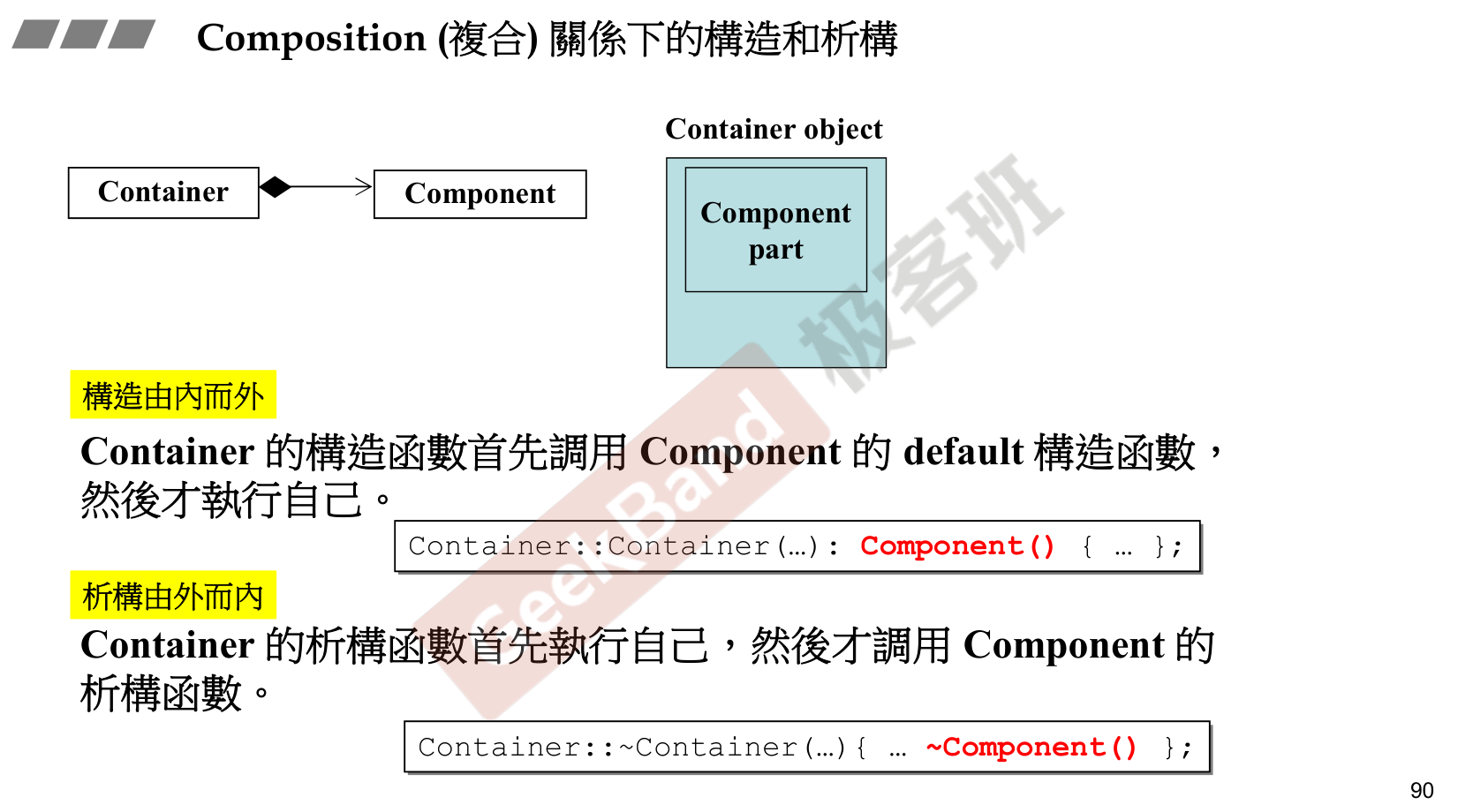
设计模式 - Adapter
queue 和 deque
template<class T>class queue { ...protected: deque <T> c; // 底層容器public: // 以下完全利用 c 的操作函數完成 bool empty() const { return c.empty(); } size_type size() const { return c.size(); } reference front() { return c.front(); } reference back() { return c.back(); } void push(const value_type &x) { c.push_back(x); } void pop() { c.pop_front(); }};Delegation (Composition by reference)
设计模式 - Handle / Body or Pointer to Implementation or PIMPL
Inheritance
构造与析构顺序
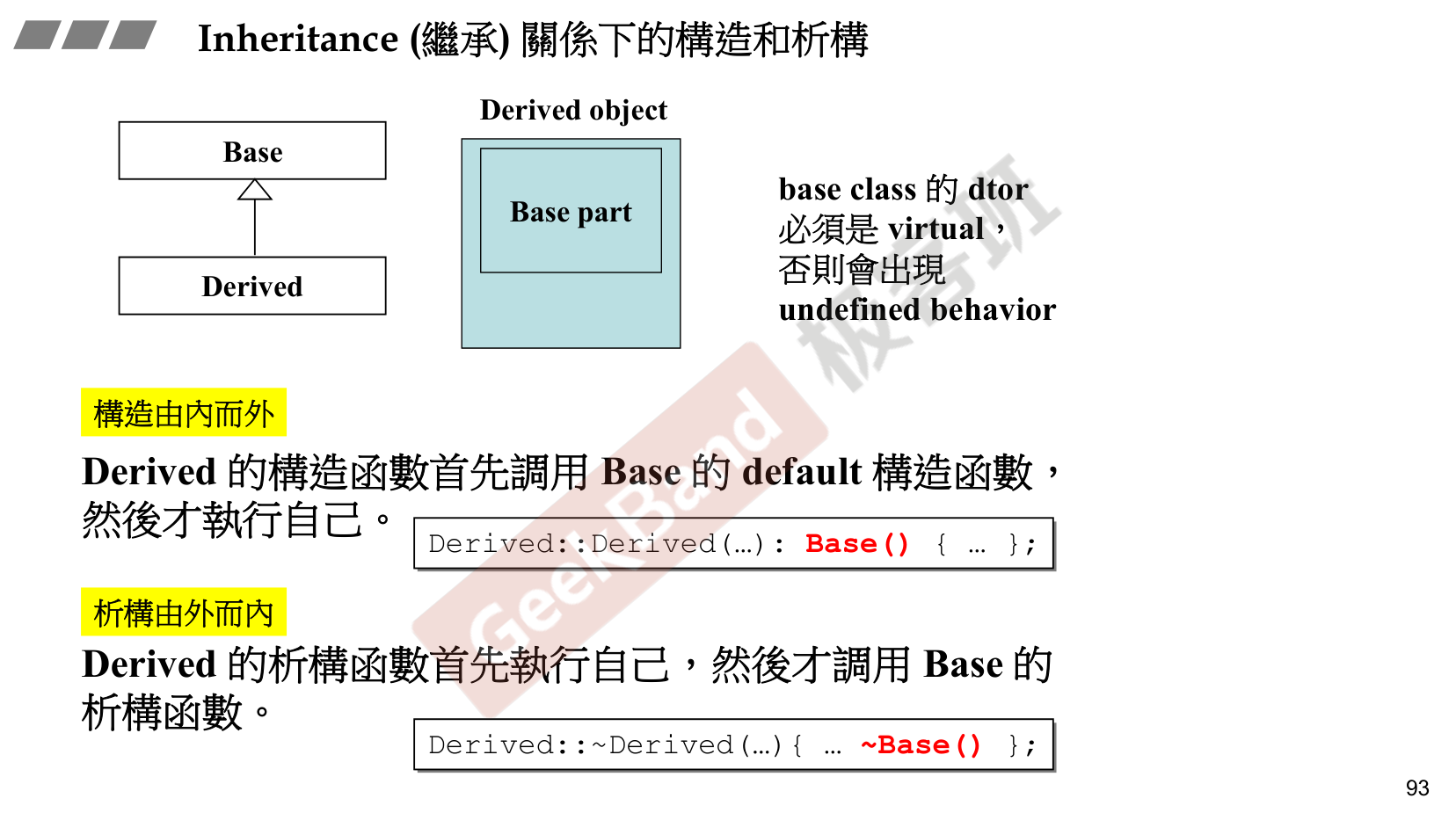
Inheritance with virtual
- non-virtual 函数 - 你不希望 derived class override 它
- virtual 函数 - 你希望 derived class override 它,且你对它已有默认定义
- pure virtual 函数 - 你希望 derived class 一定要 override 它,你对它没有默认定义
设计模式 - Template Method

Inheritance + Composition
构造与析构顺序
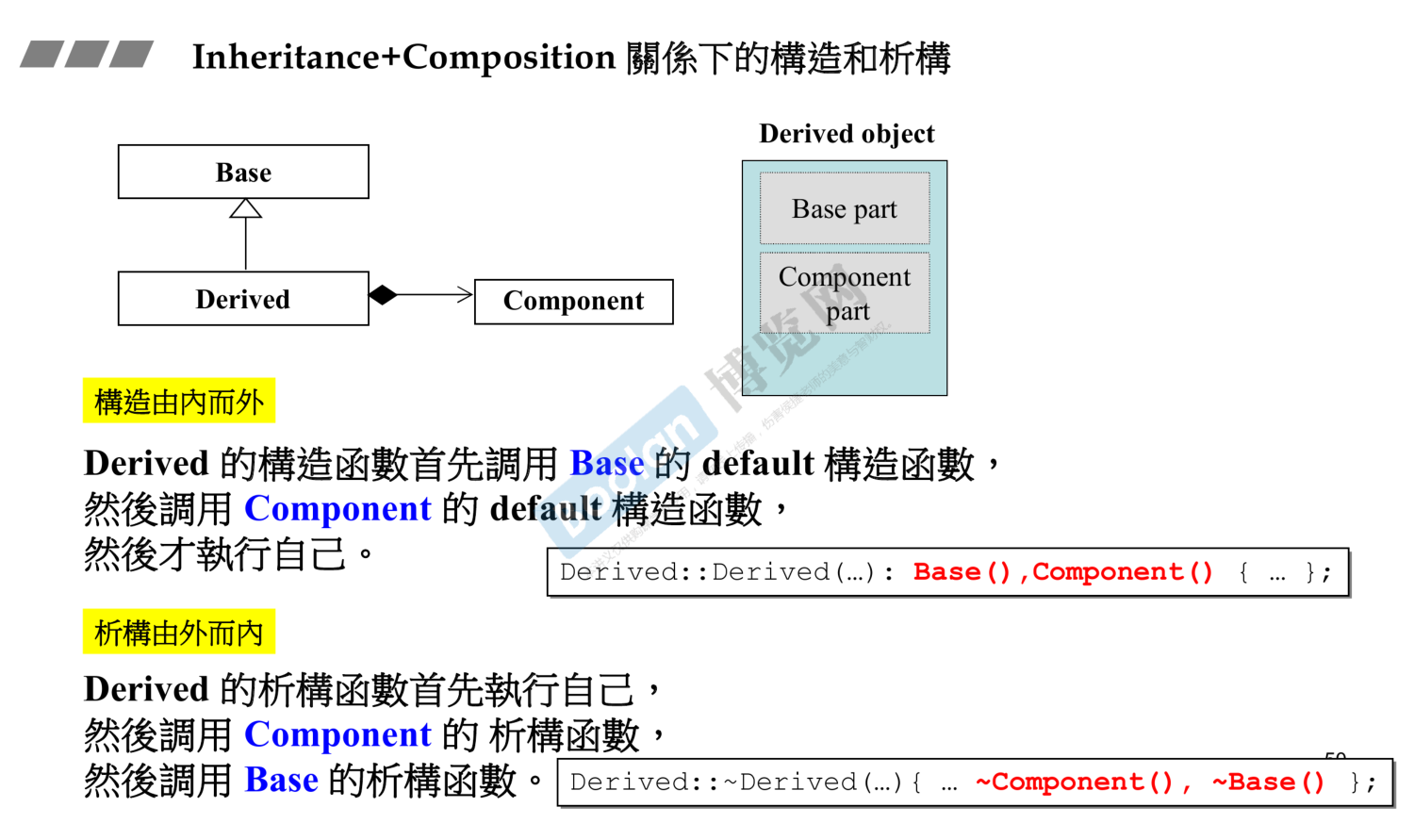
Delegation + Inheritance
设计模式 - Observer
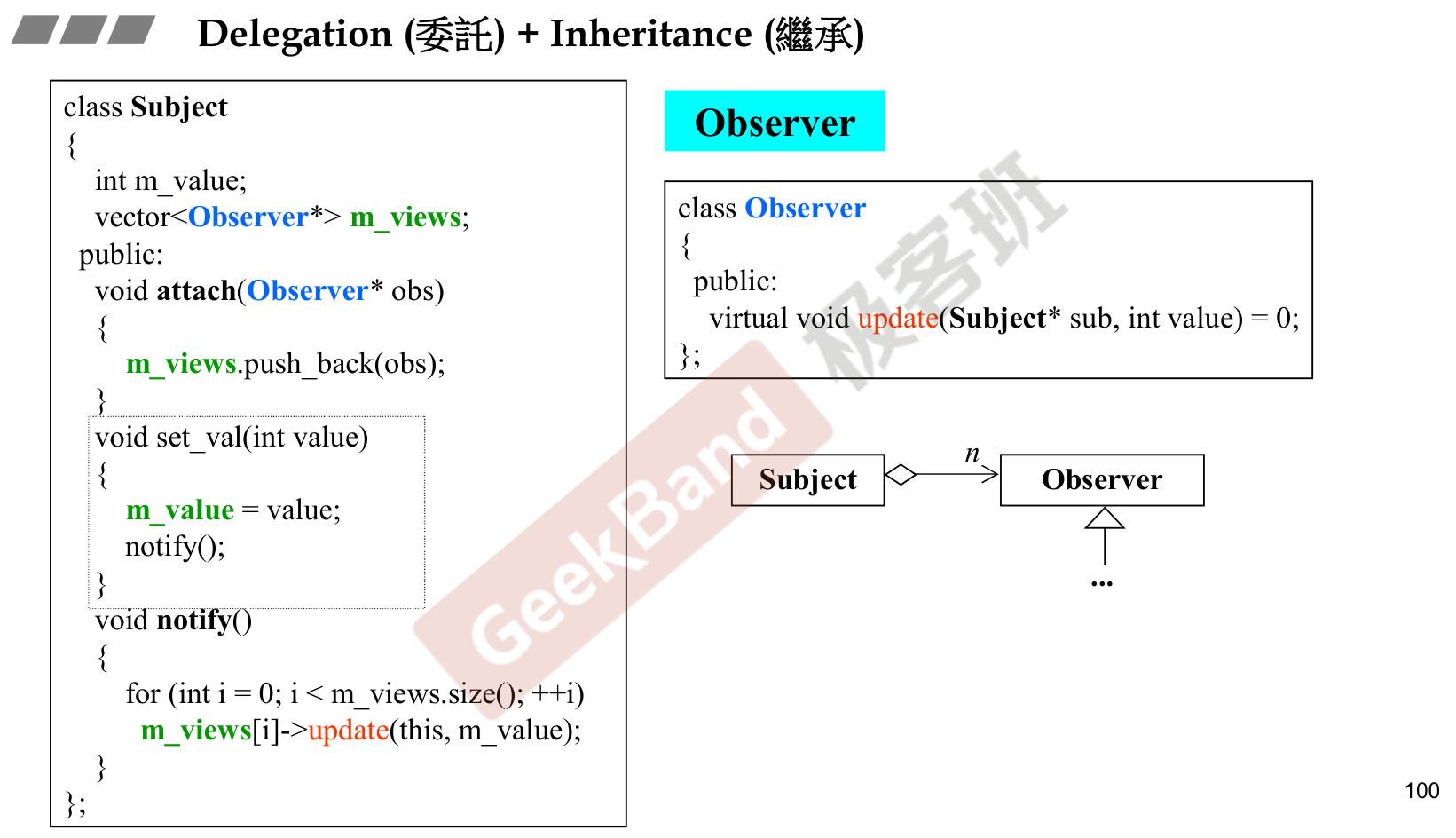
设计模式 - Composite
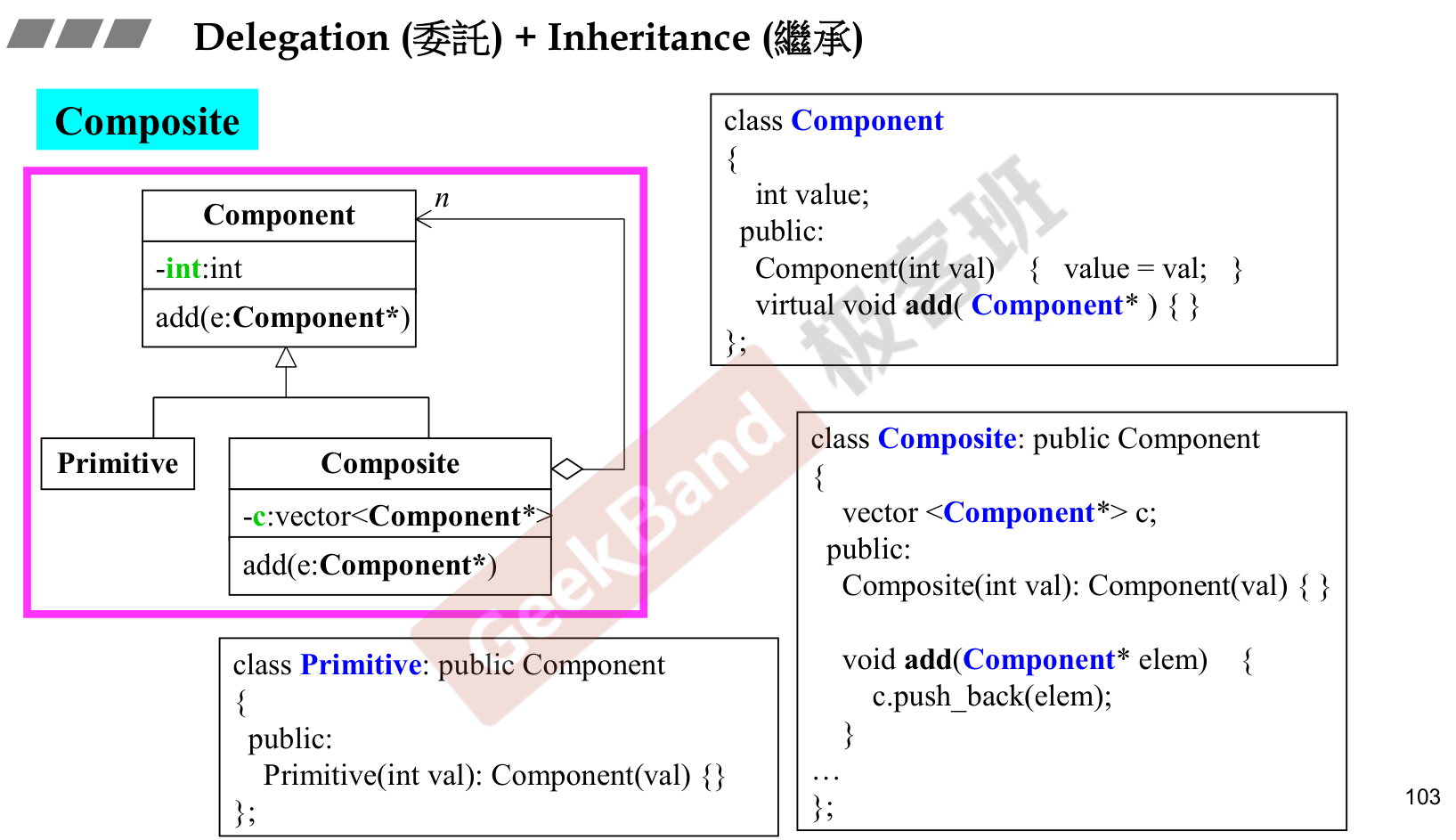
设计模式 - Prototype
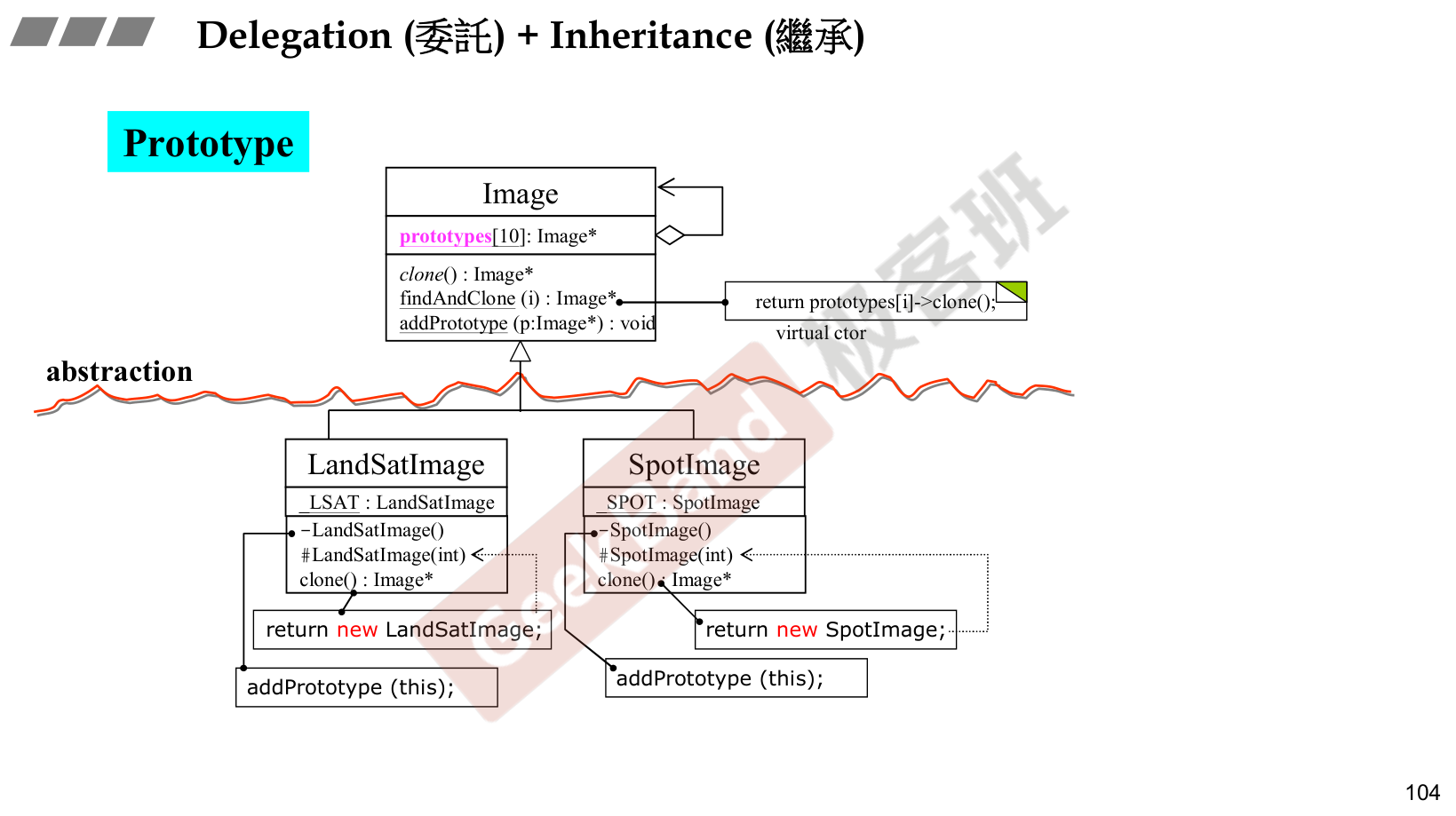
转换函数
conversion function
把类类型转换为其他类型(基本类型、类类型)
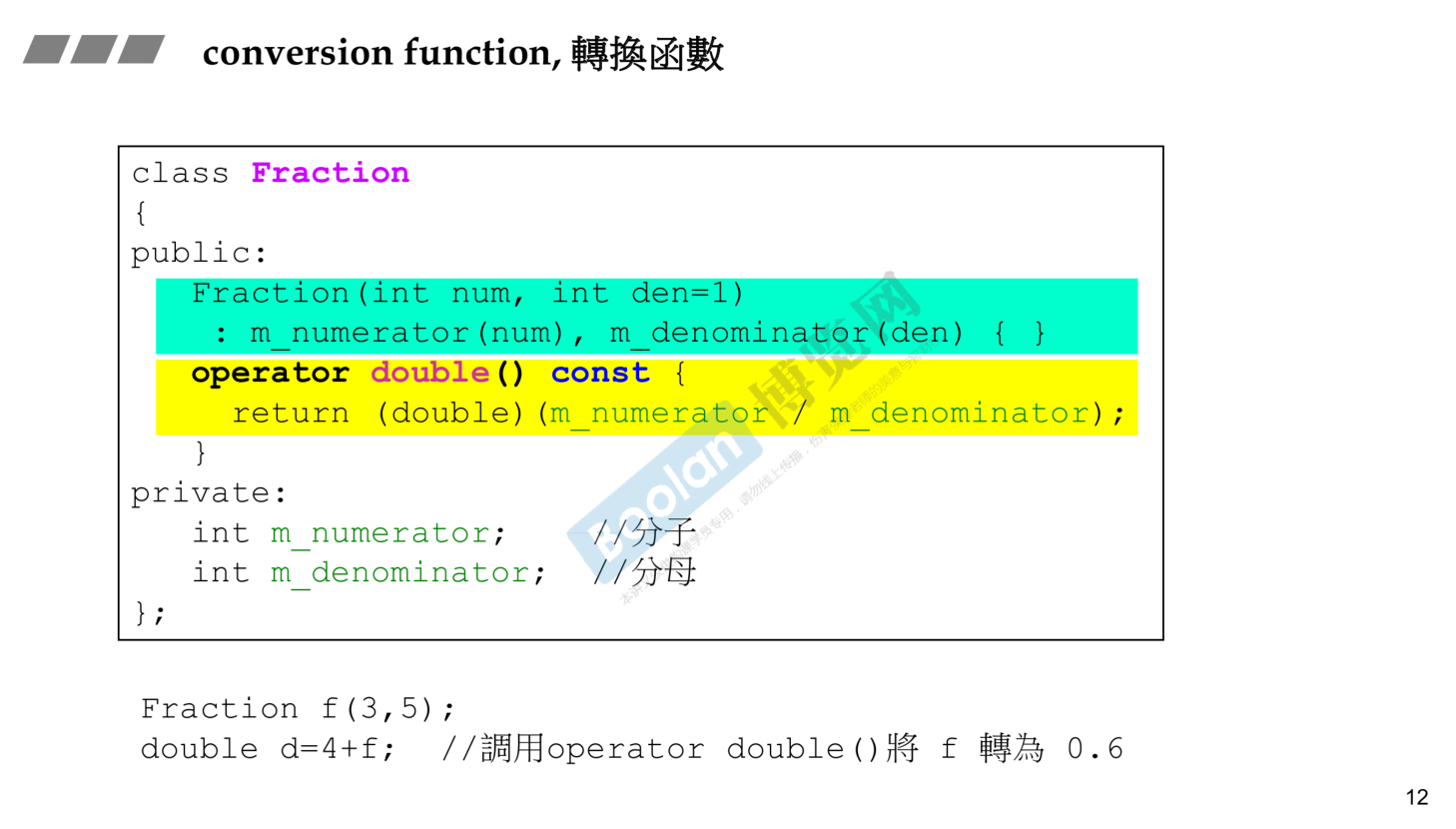
在 STL 中的实例 - 设计模式 - 代理模式

non-explicit-one-argument ctor
把其他类型(隐式)转换为类类型
配合 conversion function 可能引发二义性
在 non-explicit-one-argument ctor 或者 conversion function 前面加上 explicit,只能通过显式地进行构造
class F {private: int n_{}; int d_{};public: operator double() const { return (double) n_ / d_; }
F(int n, int d = 1) : n_{n}, d_{d} {}
F operator+(const F &f) { int n1 = this->n_; int n2 = f.n_; int d1 = this->d_; int d2 = f.d_; this->n_ = n1 * d2 + d1 * n2; this->d_ = d1 * d2; return *this; }};
int main() { F f(1, 2); F g = f + 2;}pointer-like classes
重载运算符 * 和 ->
关于智能指针
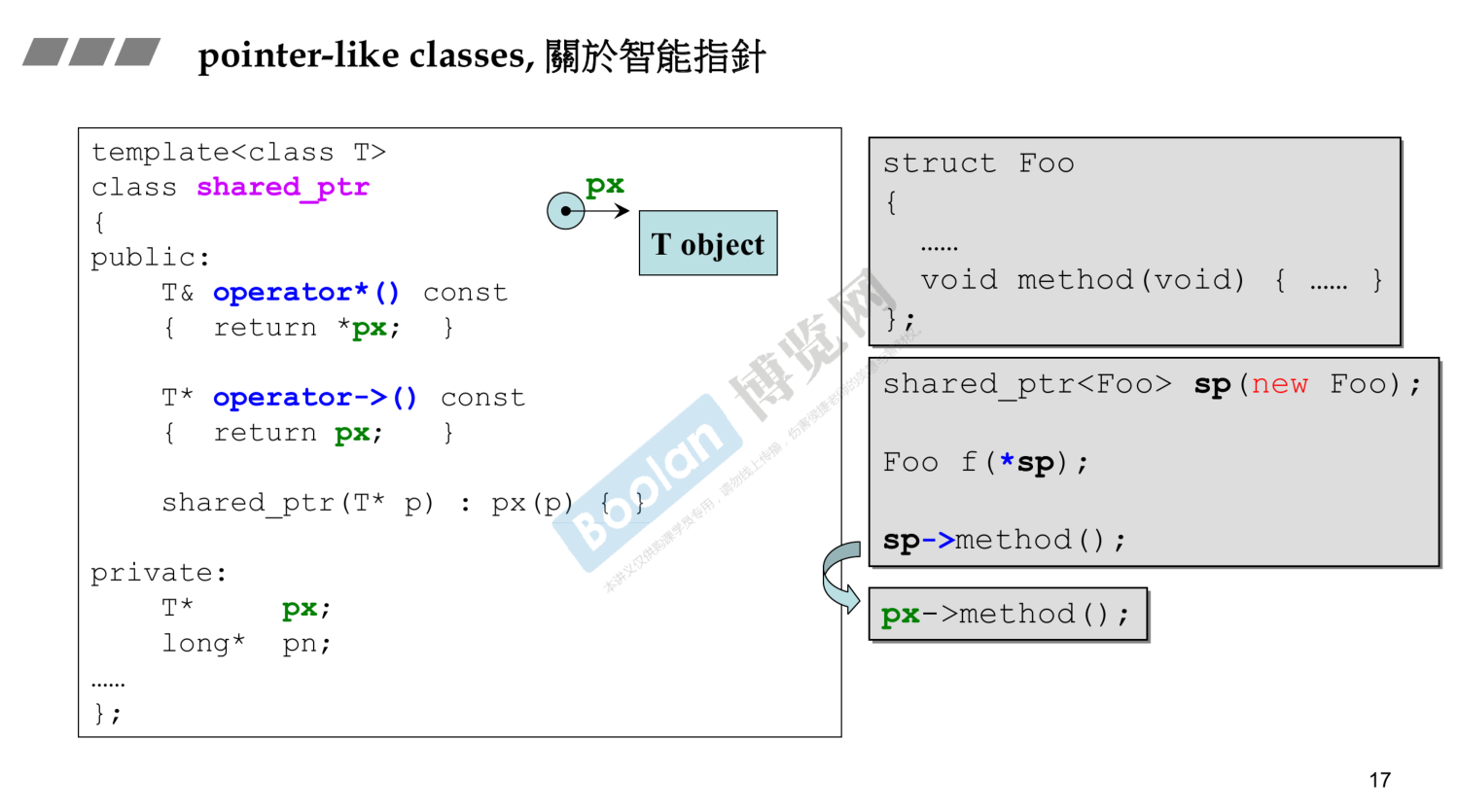
注意此处 -> 被消耗后仍然存在,这是语法定义
关于迭代器
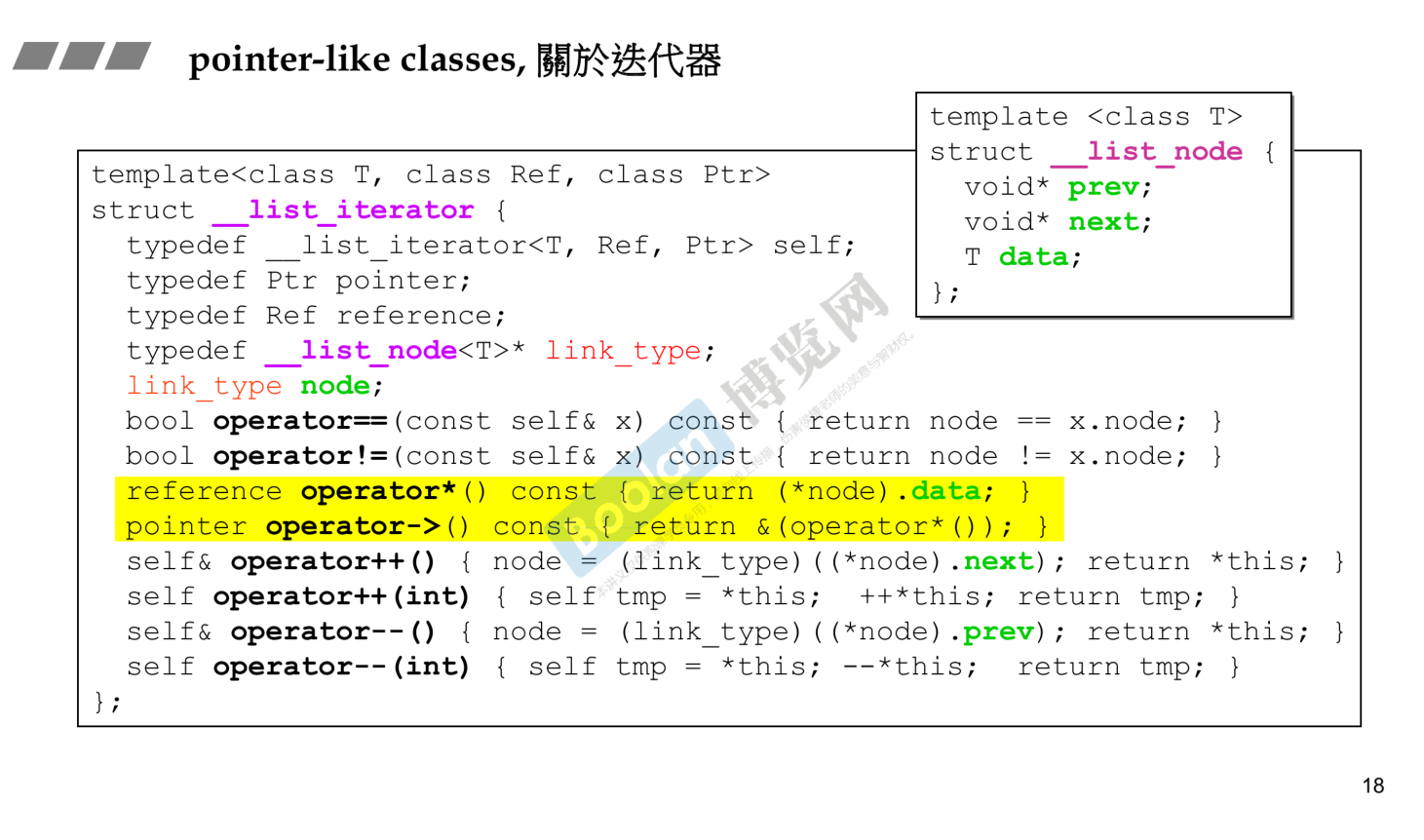
function-like classes
仿函数,函数对象
重载运算符 ()
#include <iostream>
using std::cout;
template<class T1, class T2>struct pair { typedef T1 first_type; typedef T2 second_type;
T1 first; T2 second;
pair() : first(T1()), second(T2()) {}};
template<class Pair>struct select1st { const typename Pair::first_type & operator()(const Pair &x) const { return x.first; }};
int main() { using P = pair<int, int>; P p; cout << select1st<P>()(p);}class template 类模板
template<typename T>class complex {public: complex(T r = 0, T i = 0) : re(r), im(i) {}
complex &operator+=(const complex &);
T real() const { return re; }
T imag() const { return im; }
private: T re, im;
friend complex &__doapl(complex *, const complex &);};function template 函数模板
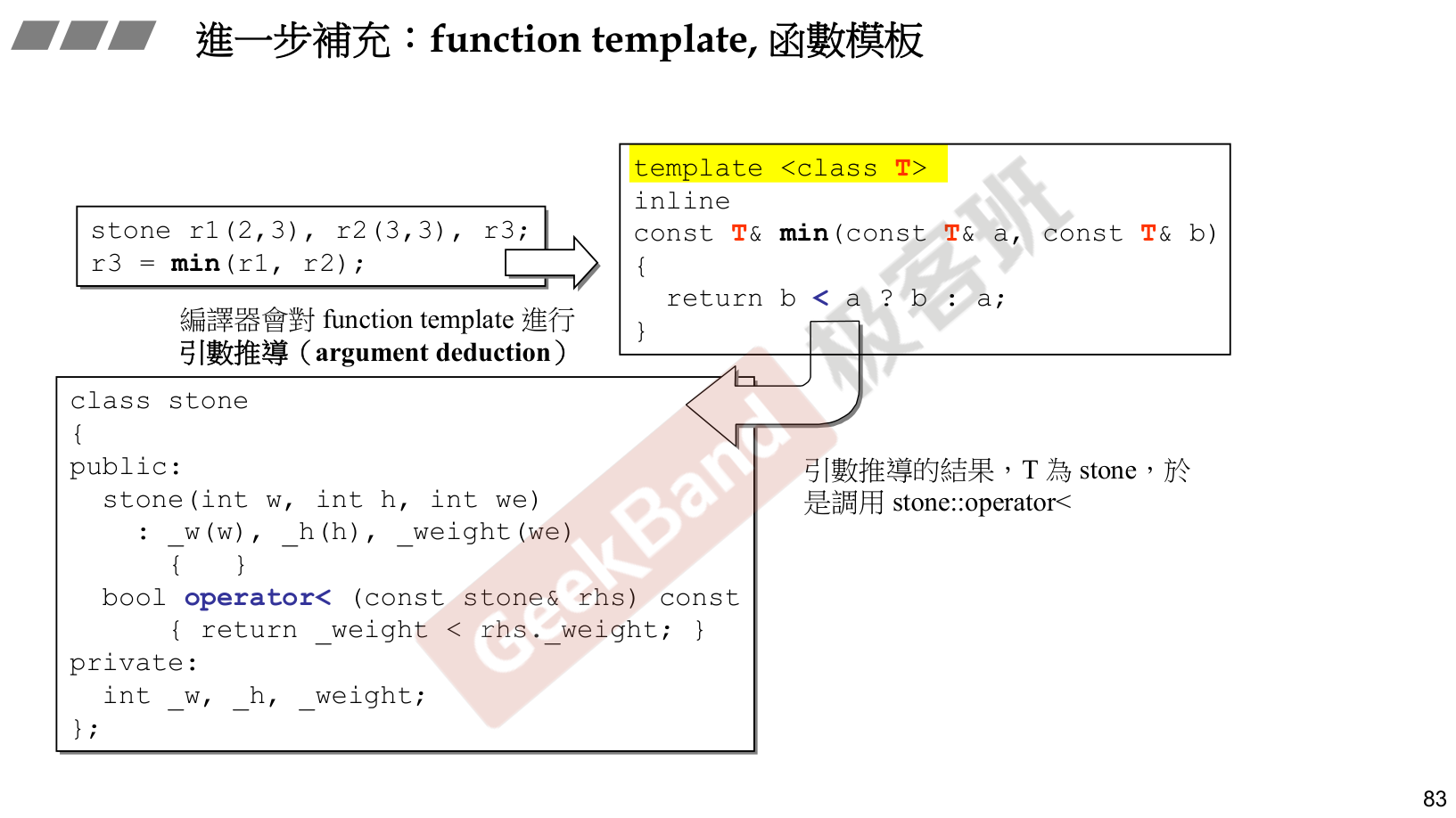
member template 成员模板
template<class T1, class T2>struct pair { typedef T1 first_type; typedef T2 second_type;
T1 first; T2 second;
pair() : first(T1()), second(T2()) {}
pair(const T1 &a, const T2 &b) : first(a), second(b) {}
template<class U1, class U2> explicit pair(const pair<U1, U2> &p) : first(p.first), second(p.second) {}};
struct Base1 {
};
struct Base2 {
};
struct Derived1 : Base1 {
};
struct Derived2 : Base2 {
};
int main() { pair<Derived1, Derived2> p1; pair<Base1, Base2> p2(p1);}这种结构通常用于实现子类到父类的转换
另一个例子是智能指针
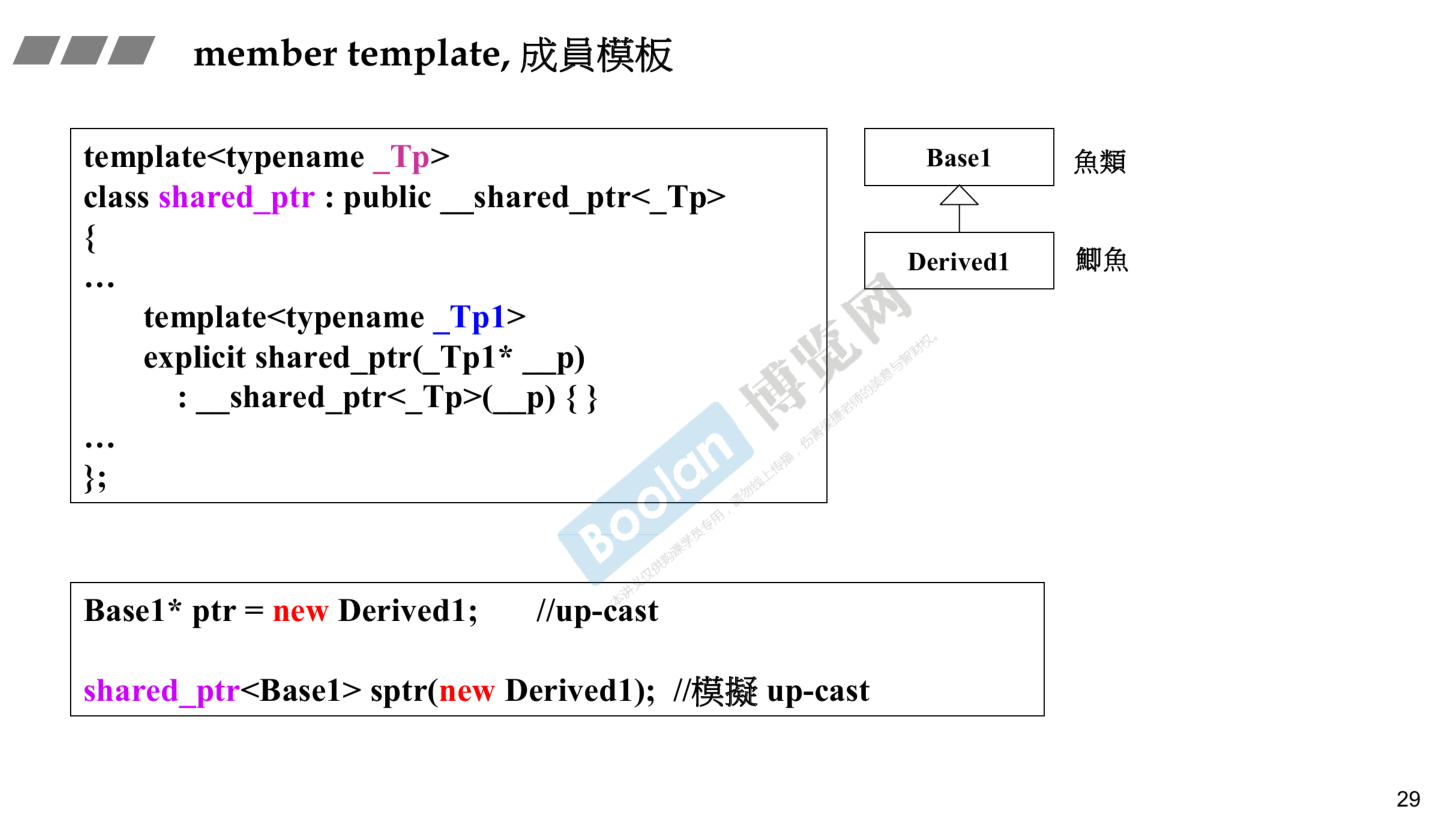
specialization 模版特化
#include <cstddef>
template<class Key>struct hash { // ...};
template<>struct hash<char> { size_t operator()(char x) const { return x; }};
template<>struct hash<int> { size_t operator()(char x) const { return x; }};
template<>struct hash<long> { size_t operator()(char x) const { return x; }};上述代码实现针对 char、int 和 long 这三个数据类型的 hash 使用指定代码,其它数据类型使用默认的通用代码
partial specialization 模版偏特化
- 个数
template<typename T, typename Alloc>class vector {};
template<typename Alloc>class vector<bool, Alloc> { // 指定了第一个参数类型};- 范围
#include <string>
using std::string;
template<typename T>class C {};
template<typename T>class C<T *> { // 指定了参数类型为指针类型};
int main() { C<string> obj1; C<string *> obj2;}template template parameter 模板模板参数
一个模板的参数是模板类型,如
template <typename T, typename Cont = std::vector<T>>class Stack {private: Cont elems; // elements // ......};实例化
Stack<int, std::deque<int>> intStack;可以看到上面这样实例化时,需要指定 int 类型两次,而且这个类型是一样的,能不能实例化直接写成
Stack<int, std::deque> intStack;很显然是可以的,使用模板的模板参数,声明形式类似
template<typename T, template<typename Elem> class Cont = std::vector>class Stack {private: Cont<T> elems; // elements // ......};上面声明中的第二个模板参数 Cont 是一个类模板,注意声明中要用到关键字 class
在 C++17 之后,模板的模板参数中的 class 也可以替换成 typename
只有类模板可以作为模板参数,这样就可以允许我们在声明 Stack 类模板的时候只指定容器的类型而不去指定容器中元素的类型
一个较为复杂的例子
#include <iostream>#include <vector>#include <deque>#include <cassert>
template<typename T, template<typename Elem, typename = std::allocator<Elem>> class Cont = std::deque>class Stack {private: Cont<T> elems; // elementspublic: void push(T const &); // push element void pop(); // pop element T const &top() const; // return top element [[nodiscard]] bool empty() const // return whether the stack is empty { return elems.empty(); }
// assign stack of elements of type T2 template<typename T2, template<typename Elem2, typename = std::allocator<Elem2>> class Cont2> Stack<T, Cont> &operator=(Stack<T2, Cont2> const &);
// to get access to private members of any Stack with elements of type T2: template<typename, template<typename, typename> class> friend class Stack;};
template<typename T, template<typename, typename> class Cont>void Stack<T, Cont>::push(T const &elem) { elems.push_back(elem); // append copy of passed elem}
template<typename T, template<typename, typename> class Cont>void Stack<T, Cont>::pop() { assert(!elems.empty()); elems.pop_back(); // remove last element}
template<typename T, template<typename, typename> class Cont>T const &Stack<T, Cont>::top() const { assert(!elems.empty()); return elems.back(); // return last element}
template<typename T, template<typename, typename> class Cont>template<typename T2, template<typename, typename> class Cont2>Stack<T, Cont> &Stack<T, Cont>::operator=(Stack<T2, Cont2> const &op2) { elems.clear(); // remove existing elements elems.insert(elems.begin(), op2.elems.begin(), op2.elems.end()); return *this;}
int main() { Stack<int> iStack; // stacks of ints Stack<float> fStack; // stacks of floats
// manipulate int stack iStack.push(1); iStack.push(2); std::cout << "iStack.top(): " << iStack.top() << '\n';
// manipulate float stack fStack.push(3.3); std::cout << "fStack.top(): " << fStack.top() << '\n';
// assign stack of different type and manipulate again fStack = iStack; fStack.push(4.4); std::cout << "fStack.top(): " << fStack.top() << '\n';
// stack for doubles using a vector as an internal container Stack<double, std::vector> vStack; vStack.push(5.5); vStack.push(6.6); std::cout << "vStack.top(): " << vStack.top() << '\n';
vStack = fStack; std::cout << "vStack: "; while (!vStack.empty()) { std::cout << vStack.top() << ' '; vStack.pop(); } std::cout << '\n';}C++ 标准库速览
-
算法
-
容器
-
迭代器
-
仿函数
reference
编译器其实把 reference 视作一种 pointer
- 引用是被引用对象的一个别名
- 引用一定要有初始化
- object 和其 reference 的大小相同,地址也相同 (假象)
#include <iostream>
using std::cout, std::endl;
typedef struct Stag { int a, b, c, d;} S;
int main(int argc, char **argv) { double x = 0; double *p = &x; double &r = x;
cout << sizeof(x) << endl; cout << sizeof(p) << endl; cout << sizeof(r) << endl;
cout << p << endl; cout << *p << endl; cout << x << endl; cout << r << endl; cout << &x << endl; cout << &r << endl;
S s; S &rs = s; cout << sizeof(s) << endl; cout << sizeof(rs) << endl; cout << &s << endl; cout << &rs << endl;
return 0;}Object Model 对象模型
关于 vptr 和 vtbl
-
vptr - virtual pointer
-
vtbl - virtual table
在讲虚指针和虚表之前,先要知道
- 当子类继承父类时,除了继承数据之外,同时会继承父类的虚函数
- 继承父类的函数,继承的其实是它的调用权,而不是大小
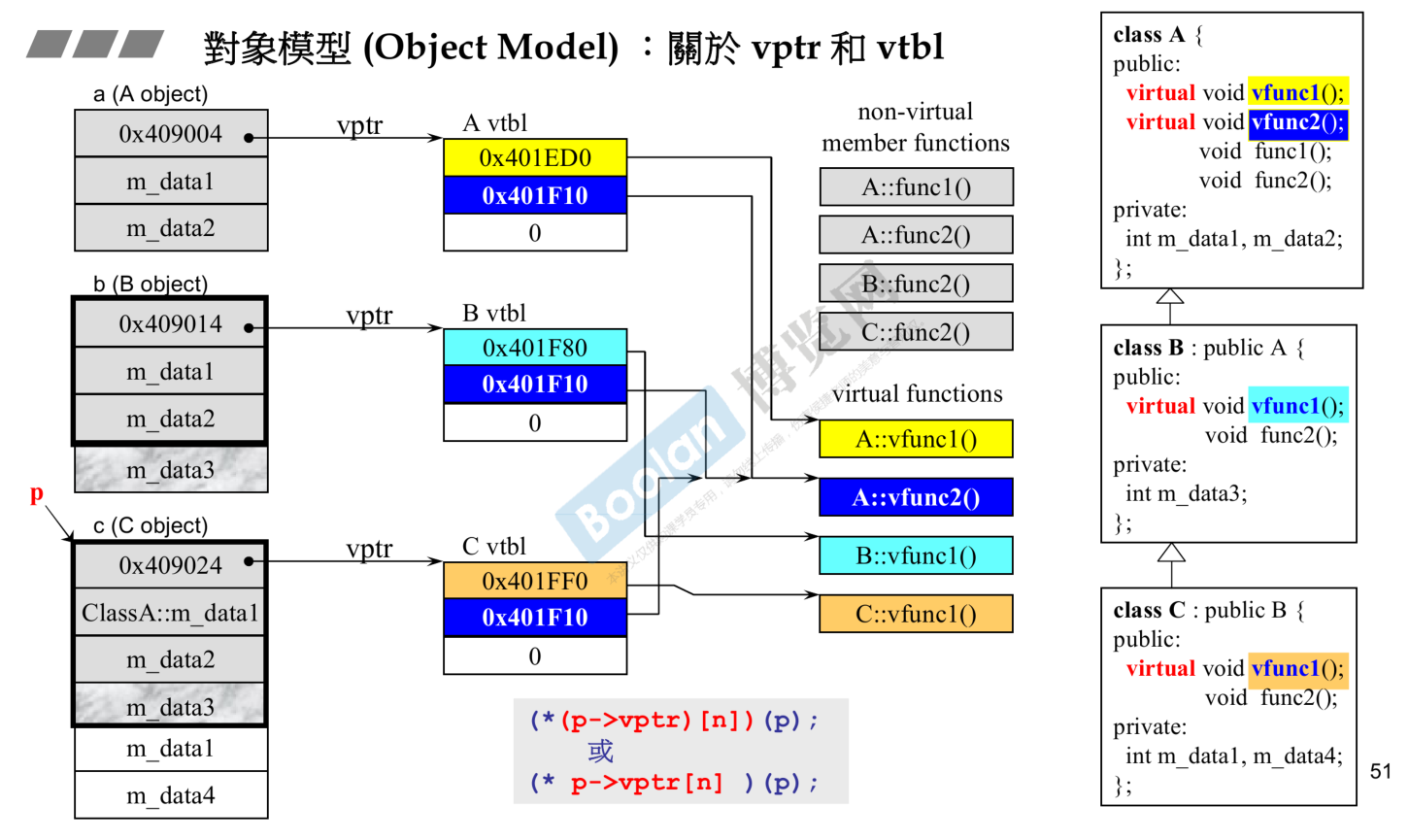
三个条件
- pointer 或 reference
- up-cast
- virtual function
关于 this
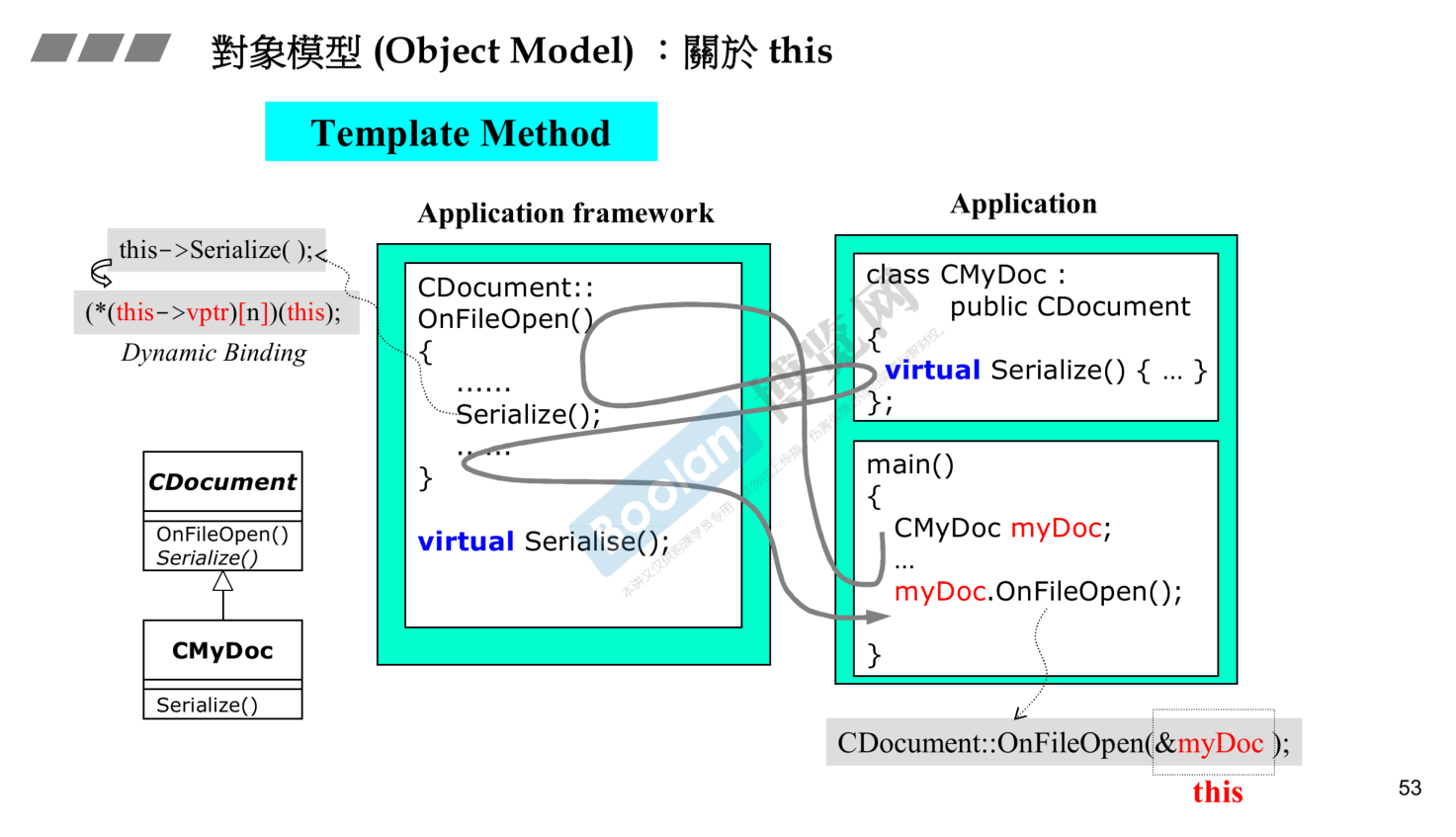
一个隐式的 this 参数
对成员函数的调用会添加 this->,从而产生可能的 Dynamic Binding
关于 Dynamic Binding
- 对于一般的非虚成员函数来说,其在内存中的地址是固定的,编译时只需将函数调用编译成
call命令即可,这被称为静态绑定 - 对于虚成员函数,调用时根据虚表
vtbl判断具体调用的实现函数,相当于先把函数调用翻译成(*(p->vptr)[n])(p),这被称为动态绑定
关于 new 和 delete
new 和 delete 作为表达式,不可以重载
但是其内部的 operator new 和 operator delete 作为操作符,可以重载
重载全局函数
::operator new::operator new[]::operator delete::operator delete[]重载成员函数
member newmember new[]member deletemember delete[]placement new
basic_string 使用 new(extra) 扩充申请量
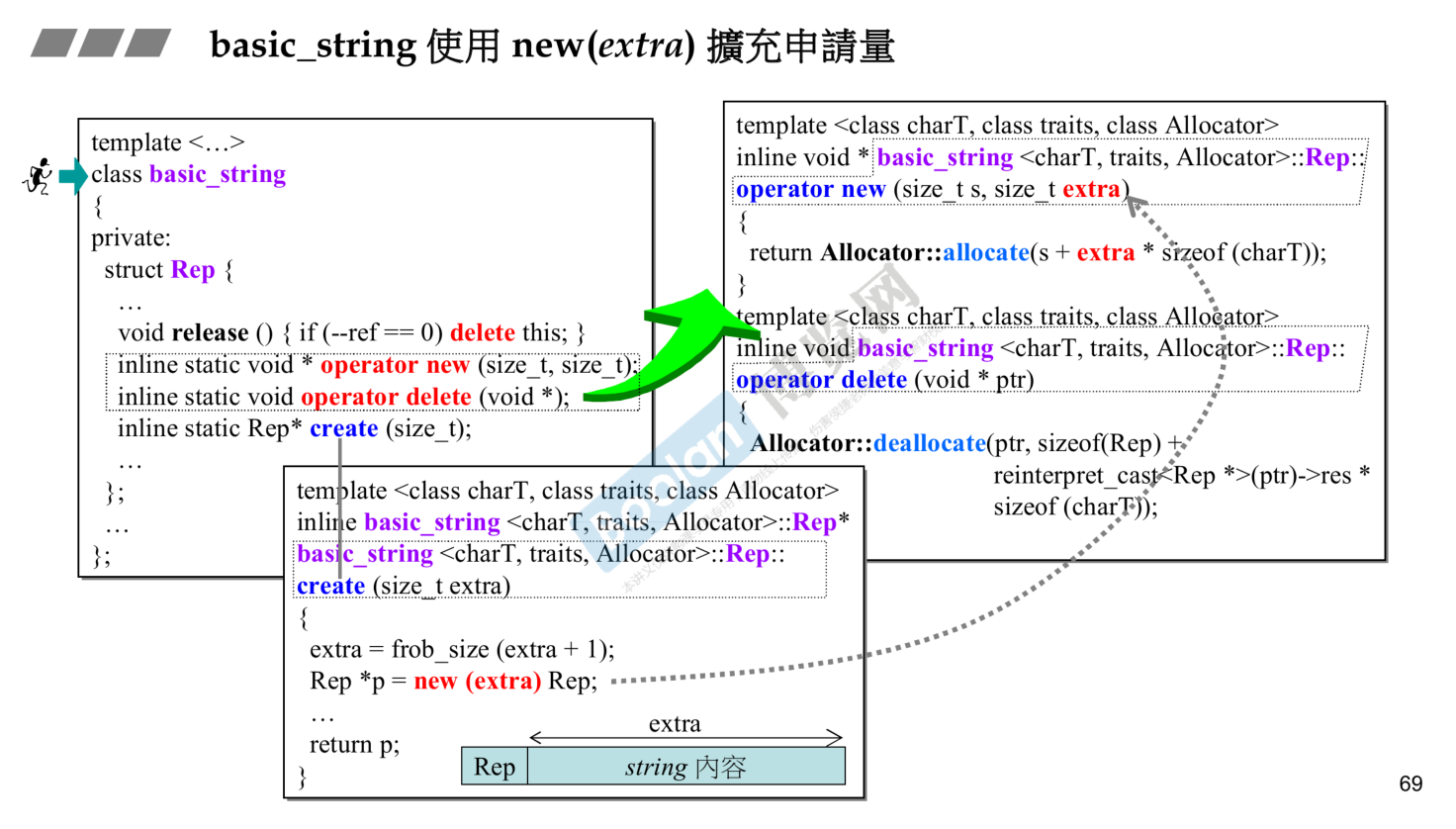
Rep 为引用计数,extra 存放实际的 string 内容
示例
#include <iostream>#include <cstdio>
using namespace std;
void *operator new(size_t size) { ::printf("global operator new with size %zu\n", size); return ::malloc(size);}
void *operator new[](size_t size) { ::printf("global operator new[] with size %zu\n", size); return ::malloc(size);}
void operator delete(void *ptr) noexcept { ::printf("global operator delete with ptr %p\n", ptr); return ::free(ptr);}
void operator delete(void *ptr, size_t size) noexcept { // with size_t arg ::printf("global operator delete with ptr %p size %zu\n", ptr, size); return ::free(ptr);}
void operator delete[](void *ptr) noexcept { ::printf("global operator delete[] with ptr %p\n", ptr); return ::free(ptr);}
struct Bad : exception {};
struct Foo { int id_{};
Foo() = default;
explicit Foo(int id) : id_{id} { throw Bad(); }
virtual ~Foo() = default;
static void *operator new(size_t size) { ::printf("member operator new with size %zu\n", size); return ::malloc(size); }
static void *operator new[](size_t size) { ::printf("member operator new[] with size %zu\n", size); return ::malloc(size); }
static void operator delete(void *ptr) { ::printf("member operator delete with ptr %p\n", ptr); ::free(ptr); }
static void operator delete[](void *ptr) { ::printf("member operator delete[] with ptr %p\n", ptr); ::free(ptr); }
// placement new functions static void *operator new(size_t size, void *start) { ::printf("member operator new with size %zu start %p\n", size, start); return start; }
static void *operator new(size_t size, size_t extra) { ::printf("member operator new with size %zu extra %zu\n", size, extra); return ::malloc(size + extra); }
// placement delete functions static void operator delete(void *ptr, void *start) { ::printf("member operator delete with ptr %p start %p\n", ptr, start); }
static void operator delete(void *ptr, size_t extra) { ::printf("member operator delete with ptr %p extra %zu\n", ptr, extra); }};
int main() { { int *foo = new int; delete foo; }
{ Foo *foo = new Foo; // 16 = roundup(4 + 8, 8) delete foo; }
{ Foo *foo = new Foo[4]; // 72 = 4 * 16 + 8 delete[] foo; }
{ Foo *foo = ::new Foo[4]; // global ::delete[] foo; }
{ void *ptr = ::malloc(sizeof(Foo)); // placement new expression Foo *foo = new(ptr) Foo; // **not** placement delete expression // delete foo; }
{ void *ptr = ::malloc(sizeof(Foo)); try { Foo *foo = new(ptr) Foo(1); } catch (Bad &bad) { ::printf("%s\n", bad.what()); } }
{ try { Foo *foo = new(4) Foo(1); } catch (Bad &bad) { ::printf("%s\n", bad.what()); } }}注意 placement delete function 是直接调用不到的东西,当 placement new expression 调用 placement new function,如果构造函数函数构造的时候发生了异常,这个时候要防止内存泄露,那么要清理掉已分配的内存,就需要这个 placement delete function
另外,对于 operator delete 的重载,可以添加可选的 size_t 参数,不过似乎会与 placement delete functions 冲突
C++ 2.0
variadic templates
数量不定的模版参数

实现递归函数,注意边界情况
#include <iostream>#include <sstream>
using namespace std;
void print() { // base case
}
template<typename T>string rep(const T &t) { ostringstream ret; ret << t; return ret.str();}
template<typename T, typename... Types>void print(const T &first, const Types &...args) { cout << sizeof...(args) << endl; cout << rep(first) << endl; print(rep(args)...);}
int main() { print("114514", 2, 3.0);}另外标准库中的 tuple 利用 variadic templates,使用递归继承的方式来实现
nullptr
Item 8: 优先考虑 nullptr 而非 0 和 NULL
uniform initialization
- 当
{}内的值与变量的类型不匹配时,不允许类型的收缩转换 - 编译器看到
{t1, t2, ... tn},便构造一个initializer_list<T>,其内部引用了array<T, n>(浅拷贝)- 调用函数如 ctor 时,该 array 内的元素可以被编译器分解逐一传给函数
- 但若不存在对应的 ctor,且存在函数参数为
initializer_list<T>的 ctor,则作为整体传入
#include <iostream>
using namespace std;
struct Foo { Foo(int a, int b) { cout << "Foo::Foo(int, int)" << endl; }
Foo(initializer_list<int> list) { cout << "Foo::Foo(initializer_list<int>)" << endl; }};
int main() { Foo foo(1, 2); Foo bar{1, 2};}explicit for ctors taking more than one argument
在多个实参的 ctors 上也可以加上关键字 explicit 来禁止做隐式转化
#include <iostream>
using namespace std;
struct Foo { Foo(int a, int b) { cout << "Foo::Foo(int, int)" << endl; }
explicit Foo(int a, int b, int c) { cout << "explicit Foo::Foo(int, int, int)" << endl; }};
int main() { Foo foo = {1, 2}; Foo bar{1, 2, 3}; // Foo bar = {1, 2, 3};}ranged-base for
for (declaration : collection){ statement;}实际上等价于
for (auto _pos = collection.begin(); _pos != collection.end(); ++_pos){ declaration = *_pos; statement;}default 和 delete
- 默认构造函数:和 C++98 规则相同。仅当类不存在用户声明的构造函数时才自动生成
- 析构函数:基本上和 C++98 相同;稍微不同的是现在析构默认 noexcept,和 C++98 一样,仅当基类析构为虚函数时该类析构才为虚函数
- 拷贝构造函数:和 C++98 运行时行为一样:逐成员拷贝 non-static 数据。仅当类没有用户定义的拷贝构造时才生成。如果类声明了移动操作它就是 delete 的。当用户声明了拷贝赋值或者析构,自动生成该函数是被废弃的行为
- 拷贝赋值运算符:和 C++98 运行时行为一样:逐成员拷贝赋值 non-static 数据。仅当类没有用户定义的拷贝赋值时才生成。如果类声明了移动操作它就是 delete 的。当用户声明了拷贝构造或者析构,自动生成该函数是被废弃的行为
- 移动构造函数和移动赋值运算符:都对非 static 数据执行逐成员移动。仅当类没有用户定义的拷贝操作,移动操作或析构时才自动生成
换句话说
- 两个拷贝操作是独立的:声明一个不会限制编译器生成另一个。尽管这是被废弃的行为
- 两个移动操作不是相互独立的。如果你声明了其中一个,编译器就不再生成另一个
三五法则
- 如果一个类定义了析构函数,那么您必须同时定义或删除拷贝构造函数和拷贝赋值函数,否则出错
- 如果一个类定义了拷贝构造函数,那么您必须同时定义或删除拷贝赋值函数,否则出错,删除可导致低效
- 如果一个类定义了移动构造函数,那么您必须同时定义或删除移动赋值函数,否则出错,删除可导致低效
- 如果一个类定义了拷贝构造函数或拷贝赋值函数,那么您必须最好同时定义移动构造函数或移动赋值函数,否则低效
Item 11: 优先考虑使用 deleted 函数而非使用未定义的私有声明
using
alias template
在 C++17 以前,下述用法会报错
template<typename T, template<typename Elem> class Cont = std::vector>class Stack {private: Cont<T> elems; // elements // ......};
int main() { Stack<int, std::vector> st{};}因为 std::vector 声明为
template <typename T, typename Allocator = std::allocator<T>> class vector;这里不会自动 deduce 出 Allocator 模板参数
所以需要写成
template<typename T, template<typename Elem> class Cont = std::vector>class Stack {private: Cont<T> elems; // elements // ......};
template<typename T>using Vec = std::vector<T, std::allocator<T>>;
int main() { Stack<int, Vec> st{};}这便使用了 alias template
在 C++17 之后,第一种写法可以通过
Matching of template template-arguments excludes compatible templates
type alias
using func = void(*)(int, int);typedef void(*func)(int, int);noexcept
Item 14: 如果函数不抛出异常请使用 noexcept
noexcept 允许编译器生成更好的目标代码
unwind 调用栈和可能 unwind 调用栈两者对于代码生成有非常大的影响
对于 std::vector 而言,其扩容默认为复制操作,可以提供异常安全保证,即如果在复制元素期间抛出异常,std::vector 状态保持不变
如果将复制操作替换为移动操作,除非知晓移动操作绝不抛异常,这时复制替换为移动就是安全的
C++11 后,默认情况下,内存释放函数和析构函数都是隐式 noexcept 的,如果一个对象的析构函数可能被标准库使用(比如在容器内或者被传给一个算法),析构函数又可能抛异常,那么程序的行为是未定义的
override
要想 override 一个函数,必须满足下列要求
- 基类函数必须是
virtual - 函数名必须完全一样(除非是析构函数)
- 函数的形参类型必须完全一样
- 函数的常量性必须完全一样
- 函数的返回值和异常说明必须兼容
- 函数的引用限定符必须完全一样
class Widget {public: … void doWork() &; // 只有 *this 为左值的时候才能被调用 void doWork() &&; // 只有 *this 为右值的时候才能被调用};…Widget makeWidget(); // 工厂函数(返回右值)Widget w; // 普通对象(左值)…w.doWork(); // 调用被左值引用限定修饰的 Widget::doWork 版本 // 即 Widget::doWork &makeWidget().doWork(); // 调用被右值引用限定修饰的 Widget::doWork 版本 // 即 Widget::doWork &&final
- 修饰类,禁止被继承
- 修饰方法,禁止被 override
auto & decltype
auto
template<typename T>void f(ParamType param);f(expr);需要根据 expr 推导出 ParamType 和 T
auto 类型推导即为模板类型推导,例如
template<typename T>void f(T& param);此处 ParamType 即为 T&
f(expr);auto ¶m = expr;ParamType 是指针或者引用,但不是万能引用
若 expr 是个引用类型,先将引用部分忽略
对 expr 的类型和 ParamType 的类型执行模式匹配,来决定 T 的类型
#include <iostream>#include <boost/type_index.hpp>
using boost::typeindex::type_id_with_cvr;
int main() { // 变量类型 int x = 27; // x 的类型是 int const int cx = x; // cx 的类型是 const int const int &rx = x; // rx 是 cx 类型为 const int 的引用
// auto 引用变量 auto &ax = x; // ax 变量的类型为 int& auto &acx = cx; // acx 变量的类型为 const int& auto &arx = rx; // arx 变量的类型为 const int&
std::cout << "ax: " << type_id_with_cvr<decltype(ax)>() << std::endl; std::cout << "acx: " << type_id_with_cvr<decltype(acx)>() << std::endl; std::cout << "arx: " << type_id_with_cvr<decltype(arx)>() << std::endl;}总结为
- 常量性保留
- 引用性忽略
ParamType 是万能引用
如果 expr 是个左值,T 和 ParamType 都会被推导为左值引用
在模版类型推导中,
T唯一被推导为左值引用的情况
如果 expr 是个右值,则按照第一种规则进行推导
#include <iostream>#include <boost/type_index.hpp>
using boost::typeindex::type_id_with_cvr;
int main() { // 变量类型 int x = 27; // x 的类型是 int const int cx = x; // cx 的类型是 const int
// auto 声明变量 auto &&ax = x; // x 类型 int,且是左值,所以 ax 是左值引用,类型为 int& auto &&acx = cx; // cx 类型 const int, 且是左值,所以 acx 是左值引用,类型为 const int & auto &&alx = 27; // 27 类型 int,为右值,所以 alx 以右值引用,类型为 int&&
std::cout << "ax: " << type_id_with_cvr<decltype(ax)>() << std::endl; std::cout << "acx: " << type_id_with_cvr<decltype(acx)>() << std::endl; std::cout << "alx: " << type_id_with_cvr<decltype(alx)>() << std::endl;}ParamType 既非指针也非引用
类似第一种规则 (忽略引用性),但也需要忽略常量性 (和易变性)
#include <iostream>#include <boost/type_index.hpp>
using boost::typeindex::type_id_with_cvr;
int main() { // 变量类型 int x = 27; // x 的类型是 int const int cx = x; // cx 的类型是 const int
// auto 声明变量 auto ax = x; // ax 的类型是 int auto acx = cx; // acx 的类型是 int
std::cout << "ax: " << type_id_with_cvr<decltype(ax)>() << std::endl; std::cout << "acx: " << type_id_with_cvr<decltype(acx)>() << std::endl;}区分 auto 和 decltype(auto)
举几个例子,对于
template<typename Container, typename Index>auto authAndAccess(Container &c, Index i) -> decltype(c[i]) { authenticateUser(); return c[i];}推导规则为 decltype 的规则
对于
template<typename Container, typename Index>auto authAndAccess(Container &c, Index i) { authenticateUser(); return c[i];}推导规则为 auto 的规则 (模板类型推导)
所以会导致下述代码失败
std::deque<int> d;authAndAccess(d, 5) = 10;若改成
template<typename Container, typename Index>decltype(auto) authAndAccess(Container &c, Index i) { authenticateUser(); return c[i];}推导规则为 decltype 的规则
区分 decltype(E) 和 decltype((E))
https://zhuanlan.zhihu.com/p/593957444
在开始值类别之前,我们先回顾一下 decltype 有哪些作用。虽然 decltype 只是一个关键字,但是 decltype(E) 对于不同的 E 是两种完全不同的运算:
- 如果
E是一个没有加括号的 id-expression (也就是x, s.field, S::field这样的表达式),那么decltype(E)返回这个变量、字段或非类型的模板参数在定义时的原本类型,如果定义时有包含左值(lvalue, &)或右值(rvalue, &&)引用,那么decltype(E)也会包含对应的引用。 - 在其他的任何情况,也包括加了括号的 id-expression (比如
(x), (s.field)),C++ 会完全隐去E类型中的引用,使得引用完全不可见。此时decltype(E)先提取E的不含引用的类型T,然后根据E的三种值类别来确定decltype(E)的结果- 当
E是 prvalue,decltype(E)返回T - 当
E是 lvalue,decltype(E)返回T& - 当
E是 xvalue,decltype(E)返回T&&
- 当
lambda
#include <iostream>
int main() { int id = 0; auto f = [id]()mutable noexcept -> void { std::cout << "id: " << id << std::endl; ++id; };
id = 42; f(); f(); f(); std::cout << id << std::endl;}注意这里的 mutable noexcept -> void
- 三个部分均为 optional
- mutable 代表是否可以修改值捕获的变量
lambda 本质上是一个 functor,所以上述程序等价于
#include <iostream>
int main() { int id = 0;
class UnNamedLocalFunction { private: int id_; public: explicit UnNamedLocalFunction(int id) : id_{id} {}
void operator()() noexcept { std::cout << "id: " << id_ << std::endl; ++id_; } };
UnNamedLocalFunction f(id);
id = 42; f(); f(); f(); std::cout << id << std::endl;}这说明了 id = 42; 的赋值不会影响内部的 id_
rvalue references
右值引用是一种新的引用类型,它可以用来减少不必要的拷贝
当赋值运算的右边是一个右值的话,那么左边的对象可以偷右边对象的资源
一般的赋值运算,实际上是 operator=,在 C++11 之前,只有 copy op=
必须有语法让我们写出一个专门处理右值的所谓 move assignment 函数
如果一个左值也想作为右值引用来使用的话,可以使用 std::move,但是必须保证 obj 后续不再使用,否则行为未定义
下面是一个具有 move aware 的 string 类,需要注意这里的移动构造和移动赋值需要加上 noexcept
#include <cstddef>#include <cstring>#include <string>
class MyString {public: static size_t DCtor; // 统计 default-ctor 调用次数 static size_t Ctor; // 统计 ctor 调用次数 static size_t CCtor; // 统计 copy-ctor 调用次数 static size_t CAsgn; // 统计 copy-asgn 调用次数 static size_t MCtor; // 统计 move-ctor 调用次数 static size_t MAsgn; // 统计 move-asgn 调用次数 static size_t Dtor; // 统计 dtor 调用次数private: char *_data{}; size_t _len;
void _init_data(const char *s) { _data = new char[_len + 1]; memcpy(_data, s, _len); _data[_len] = '\0'; }
public: // default ctor MyString() : _data(nullptr), _len(0) { ++DCtor; }
// constructor explicit MyString(const char *p) : _len(strlen(p)) { ++Ctor; _init_data(p); }
// copy constructor MyString(const MyString &str) : _len(str._len) { ++CCtor; _init_data(str._data); }
// move constructor MyString(MyString &&str) noexcept : _data(str._data), _len(str._len) { ++MCtor; str._len = 0; str._data = nullptr; }
// copy assignment MyString &operator=(const MyString &str) { ++CAsgn; if (this != &str) { if (_data) { delete _data; } _len = str._len; _init_data(str._data); } return *this; }
// move assignment MyString &operator=(MyString &&str) noexcept { ++MAsgn; if (this != &str) { if (_data) { delete _data; } _len = str._len; _data = str._data; str._len = 0; str._data = nullptr; } return *this; }
// dtor virtual ~MyString() { ++Dtor; if (_data) { delete _data; } }
bool operator<(const MyString &rhs) const { return std::string(this->_data) < std::string(rhs._data); }
bool operator==(const MyString &rhs) const { return std::string(this->_data) == std::string(rhs._data); }
char *get() const { return _data; }};
size_t MyString::DCtor = 0;size_t MyString::Ctor = 0;size_t MyString::CCtor = 0;size_t MyString::CAsgn = 0;size_t MyString::MCtor = 0;size_t MyString::MAsgn = 0;size_t MyString::Dtor = 0;
namespace std { template<> struct hash<MyString> { size_t operator()(const MyString &s) const noexcept { return hash<string>()(string(s.get())); } };}perfect forwarding
非常重要的一点是要牢记形参永远是左值,即使它的类型是一个右值引用
比如,假设
void f(Widget&& w);形参 w 是一个左值,即使传入的实参是一个右值
所以会出现下面的情况
#include <iostream>
using namespace std;
void process(int &i) { cout << "void process(int &i)" << endl;}
void process(int &&i) { cout << "void process(int &&i)" << endl;}
void forward(int &&i) { cout << "void forward(int &&i)" << endl; process(i);}
int main() { forward(1); // output // void forward(int &&i) // void process(int &i)}当出现对右值引用的传递时,就会出现问题
需要将 forward 修改为
template<typename T>void forward(T &&i) { cout << "void forward(T &&i)" << endl; process(std::forward<T>(i));}实际上这里的 T && 是一个万能引用,既可以绑定到左值,也可以绑定到右值,其实现机制为引用折叠
int x = 1;forward(x);forward(1);Item 25: 对于右值引用使用 std::move,对于万能引用使用 std::forward
inline variable
SFINAE
smart pointers
Item 19: 对于共享资源使用 std::shared_ptr
手写 std::shared_ptr
#include <iostream>#include <memory>#include <atomic>
using namespace std;
namespace smart_pointer {
template<typename T> struct defaultDeleter { void operator()(const T *ptr) { if (ptr) { delete ptr; ptr = nullptr; } } };
template<typename T, typename Deleter=defaultDeleter<T> > class shared_ptr { public: shared_ptr();
explicit shared_ptr(T *ptr);
shared_ptr(const shared_ptr &sp);
shared_ptr(shared_ptr &&sp) noexcept;
~shared_ptr();
T *operator->() const;
T &operator*() const;
operator bool() const;
shared_ptr &operator=(const shared_ptr &sp);
shared_ptr &operator=(shared_ptr &&sp);
T *get() const;
void reset(T *ptr);
void swap(shared_ptr &sp);
int count();
private: atomic<int> *use_count{}; T *ptr; };
template<typename T, typename Deleter> shared_ptr<T, Deleter>::shared_ptr() = default;
template<typename T, typename Deleter> shared_ptr<T, Deleter>::shared_ptr(T *_ptr) : ptr(_ptr), use_count(new atomic<int>(1)) {}
template<typename T, typename Deleter> shared_ptr<T, Deleter>::shared_ptr(const shared_ptr &sp) : ptr(sp.ptr), use_count(sp.use_count) { ++*use_count; }
template<typename T, typename Deleter> shared_ptr<T, Deleter>::shared_ptr(shared_ptr &&sp) noexcept { std::swap(ptr, sp.ptr); std::swap(use_count, sp.use_count); }
template<typename T, typename Deleter> shared_ptr<T, Deleter>::~shared_ptr() { if (ptr) { --*use_count; if (*use_count <= 0) { Deleter()(ptr); delete use_count; cout << "shared_ptr dctor" << endl; } } }
template<typename T, typename Deleter> T *shared_ptr<T, Deleter>::operator->() const { return ptr; }
template<typename T, typename Deleter> T &shared_ptr<T, Deleter>::operator*() const { return *ptr; }
template<typename T, typename Deleter> shared_ptr<T, Deleter>::operator bool() const { return ptr != nullptr; }
template<typename T, typename Deleter> shared_ptr<T, Deleter> &shared_ptr<T, Deleter>::operator=(const shared_ptr<T, Deleter> &sp) { if (sp.ptr == ptr) { return *this; }
ptr = sp.ptr; use_count = sp.use_count; ++*use_count; return *this; }
template<typename T, typename Deleter> shared_ptr<T, Deleter> &shared_ptr<T, Deleter>::operator=(shared_ptr<T, Deleter> &&sp) { std::swap(ptr, sp.ptr); std::swap(use_count, sp.use_count); return *this; }
template<typename T, typename Deleter> T *shared_ptr<T, Deleter>::get() const { return ptr; }
template<typename T, typename Deleter> void shared_ptr<T, Deleter>::reset(T *_ptr) { shared_ptr<T, Deleter>().swap(*this);
ptr = _ptr; use_count = new atomic<int>(1); }
template<typename T, typename Deleter> void shared_ptr<T, Deleter>::swap(shared_ptr<T, Deleter> &sp) { std::swap(ptr, sp.ptr); std::swap(use_count, sp.use_count); }
template<typename T, typename Deleter> int shared_ptr<T, Deleter>::count() { return *use_count; }
}; // namespace smart_pointer
int main(int argc, char *argv[]) { { smart_pointer::shared_ptr<int> p(new int(12)); smart_pointer::shared_ptr<int> p1(p); *p1 = 2; cout << *p << endl; cout << p.count() << endl;
// 异常安全测试 p = p; cout << *p << endl; cout << p.count() << endl; }
{ smart_pointer::shared_ptr<int> p(new int(12)); p.reset(new int(13)); cout << *p << endl;
// 右值赋值测试 p = smart_pointer::shared_ptr<int>(new int(14)); cout << *p << endl;
// 移动构造测试 smart_pointer::shared_ptr<int> p1(smart_pointer::shared_ptr<int>(new int(15))); cout << *p1 << endl; }
return 0;}